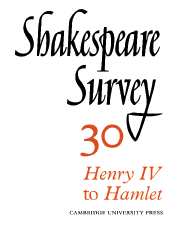Book contents
- Frontmatter
- ‘Henry IV’ and ‘Hamlet’
- Prince Hal and Tragic Style
- The True Prince and the False Thief: Prince Hal and the Shift of Identity
- Falstaff, the Prince, and the Pattern of ‘2 Henry IV’
- Whatever Happened to Prince Hal?: An Essay on ‘Henry V’
- ‘Henry V’ and the Bees’ Commonwealth
- ‘All’s Well that Ends Well’
- ‘Hamlet’ and the Power of Words
- Hamlet the Bonesetter
- ‘Hamlet’: A Time to Die
- Shakespeare, Lyly and Ovid: The Influence of ‘Gallathea’ on ‘A Midsummer Night’s Dream’
- Making a Scene: Language and Gesture in ‘Coriolanus’
- Freedom and Loss in ‘The Tempest’
- Inigo Jones at The Cockpit
- Theory and Practice: Stratford 1976
- The Year's Contributions to Shakespearian Study 1 Critical Studies
- 2 Shakespeare’s Life, Times, and Stage
- 3 Textual Studies
- Index
- Plate Section
Prince Hal and Tragic Style
Published online by Cambridge University Press: 28 March 2007
- Frontmatter
- ‘Henry IV’ and ‘Hamlet’
- Prince Hal and Tragic Style
- The True Prince and the False Thief: Prince Hal and the Shift of Identity
- Falstaff, the Prince, and the Pattern of ‘2 Henry IV’
- Whatever Happened to Prince Hal?: An Essay on ‘Henry V’
- ‘Henry V’ and the Bees’ Commonwealth
- ‘All’s Well that Ends Well’
- ‘Hamlet’ and the Power of Words
- Hamlet the Bonesetter
- ‘Hamlet’: A Time to Die
- Shakespeare, Lyly and Ovid: The Influence of ‘Gallathea’ on ‘A Midsummer Night’s Dream’
- Making a Scene: Language and Gesture in ‘Coriolanus’
- Freedom and Loss in ‘The Tempest’
- Inigo Jones at The Cockpit
- Theory and Practice: Stratford 1976
- The Year's Contributions to Shakespearian Study 1 Critical Studies
- 2 Shakespeare’s Life, Times, and Stage
- 3 Textual Studies
- Index
- Plate Section
Summary
There is one stage direction in an interlude of 1567, called Horestes, or an interlude of Vice, probably by John Pickeryng, which is worth, I think, all the rest of the text. After Horestes’s assault upon the castle of Clytemnestra and Aegisthus, and his battle (which, we are told, must be as long as possible), the play becomes for some pages a moral debate between Nature and Horestes over the punishment of his mother. Once Horestes has captured Clytemnestra, and ordered Aegisthus killed, he has to decide what to do with her – and he must decide this by himself, for Electra doesn’t appear in this little interlude. He gets counsel, however, from another source – the Vice, of course, who has been previously unnamed, but who soon identifies himself: his name is Revenge. Horestes is given very few lines at this point in the play, though the decision is one of some moment; and one can’t help the feeling that John Pickeryng, whoever he was, suddenly found himself with a character on his hands who needed more words than he knew how to provide. Nature urges Horestes not to become a matricide, and offers all the right reasons in lumbering fourteeners; but the Vice approaches, tells Horestes that his name is, after all, Revenge, and offers to solve his problem for him; let him kill Clytemnestra. It is here, in the margin of the text, where the stage direction to which I have referred is printed: ‘Here Horestes sigheth hard.’
- Type
- Chapter
- Information
- Shakespeare Survey , pp. 13 - 28Publisher: Cambridge University PressPrint publication year: 1977



